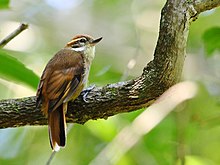| Atlantic plain xenops | |
|---|---|

| |
| Conservation status | |
 Least Concern (IUCN 3.1) | |
| Scientific classification | |
| Domain: | Eukaryota |
| Kingdom: | Animalia |
| Phylum: | Chordata |
| Class: | Aves |
| Order: | Passeriformes |
| Family: | Furnariidae |
| Genus: | Xenops |
| Species: | X. minutus |
| Binomial name | |
| Xenops minutus (Sparrman, 1788) | |
The Atlantic plain xenops (Xenops minutus), formerly known as the white-throated xenops, is a passerine bird in the Furnariinae subfamily of the ovenbird family Furnariidae. It is found in Argentina, Brazil, and Paraguay.
Taxonomy and systematics
The Atlantic plain xenops was formerly considered a subspecies of the Amazonian plain xenops (now Xenops genibarbis, formerly X. minutus). HBW recognized the split by 2018 and the IOC followed suit in July 2023. However, the South American Classification Committee of the American Ornithological Society (SACC) and the Clements taxonomy retain it as a subspecies of the plain xenops. The SACC does state that Xenops minutus sensu lato might consist of more than one species.
The Atlantic plain xenops is monotypic: No subspecies are recognized.
Description
The Atlantic plain xenops is about 12 cm (4.7 in) long and weighs about 10 to 13 g (0.35 to 0.46 oz). Its bill is wedge-shaped, fairly stubby, and slightly upturned. The sexes are alike and juveniles resemble adults. Adults have a conspicuous buff or whitish supercilium and a wide pure white malar stripe. Their upperparts are dull brown to rufous brown and unstreaked; their crown is darker and lightly streaked. Their tail is cinnamon with much black. Their wings are also cinnamon, with a wide tawny or ochraceous band on the flight feathers. Their throat is pale with little or no streaking. The rest of their underparts are plain dull grayish brown. Their iris is dark brown, their maxilla dull black, their mandible dull grayish white with a dark gray tip, and their legs and feet bluish gray.
Distribution and habitat
The Atlantic plain xenops is found in eastern and southeastern Brazil from Bahia state south to Santa Catarina state, eastern Paraguay, and northern Argentina's Misiones Province. It inhabits the interior and edges of a variety of forested landscapes including terra firme forests in the tropical lowlands, semideciduous forest, mature secondary forest, and gallery forest. In elevation it occurs from sea level to 1,500 m (4,900 ft).
Behavior
Movement
The Atlantic plain xenops is a year-round resident throughout its range.
Feeding
The Atlantic plain xenops' diet is almost entirely arthropods, both adult and larval. It has been recorded eating termites, Hymenoptera like ants and bees, beetles, katydids, millipedes, and spiders. It typically forages from the forest understory to its mid level but does ascend to the canopy. It often joins mixed-species foraging flocks. It captures prey by gleaning, hammering, chiseling, and prying with its upturned bill. It does much of its foraging on fairly thin dead branches, often rotten ones and those that have fallen into the understory, and also feeds along vines.
Breeding
The Atlantic plain xenops' breeding biology has not been studied but is assumed to be similar to that of its former "parent" species, the plain xenops, for which see here: Plain xenops#Breeding.
|
Songs and calls Listen to white-throated xenops in the plain xenops list on xeno-canto |
Vocalization
The Atlantic plain xenops' song is an "extr. high, hurried series of 5-10 x 'seep---' ".
Status
The IUCN has assessed the Atlantic plain xenops as being of Least Concern. It has a fairly large range, but its population size is not known and is believed to be decreasing. No immediate threats have been identified.
References
- ^ BirdLife International. (2017) . "White-throated Xenops Xenops minutus". IUCN Red List of Threatened Species. 2017: e.T103670750A112378962. doi:10.2305/IUCN.UK.2017-1.RLTS.T103670750A112378962.en. Retrieved 16 August 2023.
- ^ Gill, Frank; Donsker, David; Rasmussen, Pamela, eds. (August 2024). "Ovenbirds, woodcreepers". IOC World Bird List Version 14.2. International Ornithologists' Union. Retrieved 3 September 2024.
- HBW and BirdLife International (2022) Handbook of the Birds of the World and BirdLife International digital checklist of the birds of the world. Version 7. Available at: http://datazone.birdlife.org/userfiles/file/Species/Taxonomy/HBW-BirdLife_Checklist_v7_Dec22.zip retrieved December 13, 2022
- Remsen, J. V. Jr., J. I. Areta, E. Bonaccorso, S. Claramunt, G. Del-Rio, A. Jaramillo, D. F. Lane, M. B. Robbins, F. G. Stiles, and K. J. Zimmer. Version 31 May 2023. A classification of the bird species of South America. American Ornithological Society. https://www.museum.lsu.edu/~Remsen/SACCBaseline.htm retrieved May 31, 2023
- Clements, J. F., T. S. Schulenberg, M. J. Iliff, T. A. Fredericks, J. A. Gerbracht, D. Lepage, S. M. Billerman, B. L. Sullivan, and C. L. Wood. 2022. The eBird/Clements checklist of birds of the world: v2022. Downloaded from https://www.birds.cornell.edu/clementschecklist/download/ retrieved November 10, 2022
- ^ Decker, S. (2020). Plain Xenops (Xenops minutus), version 1.0. In Birds of the World (T. S. Schulenberg, Editor). Cornell Lab of Ornithology, Ithaca, NY, USA. https://doi.org/10.2173/bow.plaxen1.01 retrieved August 16, 2023
- ^ van Perlo, Ber (2009). A Field Guide to the Birds of Brazil. New York: Oxford University Press. p. 228. ISBN 978-0-19-530155-7.
